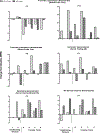Environmental cues can indirectly acquire cocaine-eliciting changes in Heart Rate: A pilot study of derived relational responding, the transfer of function among cocaine users
- PMID: 39006304
- PMCID: PMC11238519
- DOI: 10.1007/s40732-023-00554-0
Environmental cues can indirectly acquire cocaine-eliciting changes in Heart Rate: A pilot study of derived relational responding, the transfer of function among cocaine users
Abstract
Identifying the processes by which environmental stimuli can come to influence drug use is important for developing more efficacious interventions. This study investigated derived relational responding and the transfer of differential conditioned effects of environmental stimuli paired with "smoked" cocaine in accordance with the relations of symmetry, transitivity, and equivalence using Heart Rate as the measure of conditioning among 12 adults with significant histories of cocaine use. Match-to-sample (MTS) procedures were used to test for emergent relations among two four-member stimulus groupings. One member of a group was then paired with 25-mg of smoked cocaine and one member of the other group was paired with 0-mg of smoked cocaine. 10 participants completed the MTS protocol: 4 participants demonstrated two four-member equivalence classes, 3 participants demonstrated two three-member equivalence classes and 2 participants demonstrated symmetry only. One participant demonstrated no derived relations. Differential respondent elicited changes in HR was demonstrated in the presence of stimuli paired with smoked cocaine among 4 of the 6 participants completing the conditioning phase; all 4 of the participants demonstrated a bi-directional transfer of these functions in accordance with symmetry. Transfer was not reliably demonstrated in accordance with transitive or equivalence relations. The results suggest that drug respondent elicitation in the context of drug use may be a function of both direct conditioning and relational processes. These findings have implications for studying and understanding the processes by which stimuli in the natural ecology can set the occasion for cocaine use and developing cocaine use disorder.
Keywords: Cocaine Use Disorders; Derived Relations; Respondent Conditioning; Stimulus Equivalence; Transfer of Respondent Eliciting Functions.
Conflict of interest statement
Conflict of Interest: The authors of the study report no conflict of interest.
Figures







Similar articles
-
Transfer of aversive respondent elicitation in accordance with equivalence relations.J Exp Anal Behav. 2009 Jul;92(1):85-111. doi: 10.1901/jeab.2009.92-85. J Exp Anal Behav. 2009. PMID: 20119523 Free PMC article.
-
The transfer of respondent eliciting and extinction functions through stimulus equivalence classes.J Exp Anal Behav. 1994 Nov;62(3):331-51. doi: 10.1901/jeab.1994.62-331. J Exp Anal Behav. 1994. PMID: 16812745 Free PMC article.
-
Conditioned effects of environmental stimuli paired with smoked cocaine in humans.Psychopharmacology (Berl). 2000 Mar;149(1):24-33. doi: 10.1007/s002139900340. Psychopharmacology (Berl). 2000. PMID: 10789879 Clinical Trial.
-
Emotional Faces in Symbolic Relations: A Happiness Superiority Effect Involving the Equivalence Paradigm.Front Psychol. 2019 Apr 30;10:954. doi: 10.3389/fpsyg.2019.00954. eCollection 2019. Front Psychol. 2019. PMID: 31114529 Free PMC article.
-
All stimuli are equal, but some are more equal than others: measuring relational preferences within an equivalence class.J Exp Anal Behav. 2012 Nov;98(3):243-56. doi: 10.1901/jeab.2012.98-243. J Exp Anal Behav. 2012. PMID: 23144503 Free PMC article.
References
-
- Adams BJ, Fields L, & Verhave T (1993). Effects of test order on intersubject variability during equivalence class formation. The Psychological Record, 43(1), 133–151.
-
- Aharonovich E, Hasin DS, Brooks AC, Liu X, Bisaga A, & Nunes EV (2006). Cognitive deficits predict low treatment retention in cocaine dependent patients. Drug and Alcohol Dependence, 81(3), 313–322. - PubMed
-
- Aharonovich E, Hasin DS, Nunes EV, Stohl M, Cannizzaro D, Sarvet A, Bolla K, Carroll KM, & Genece KG (2018). Modified cognitive behavioral therapy (M-CBT) for cocaine dependence: Development of treatment for cognitively impaired users and results from a Stage 1 trial. Psychology of Addictive Behaviors, 32(7), 800–811. - PMC - PubMed
-
- Augustson EM, & Dougher MJ (1997). The transfer of avoidance evoking functions through stimulus equivalence classes. Journal of Behavior Therapy and Experimental Psychiatry, 28, 181–191. - PubMed
-
- Barnes D, & Holmes Y (1991). Radical behaviorism, stimulus equivalence, and human cognition. The Psychological Record, 41(1), 19–31.
Grants and funding
LinkOut - more resources
Full Text Sources
